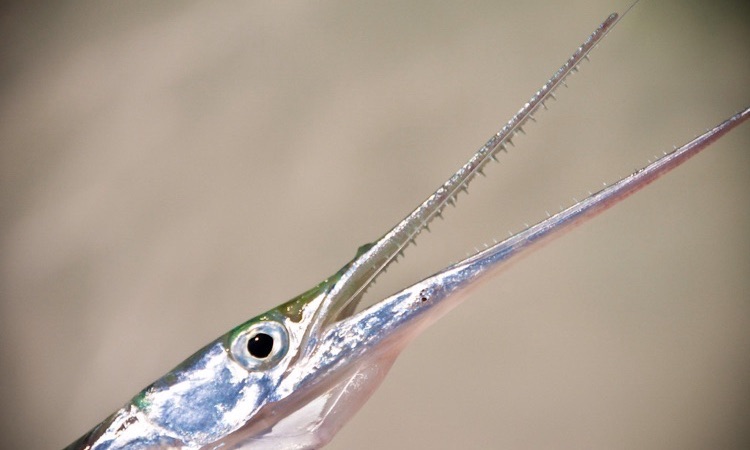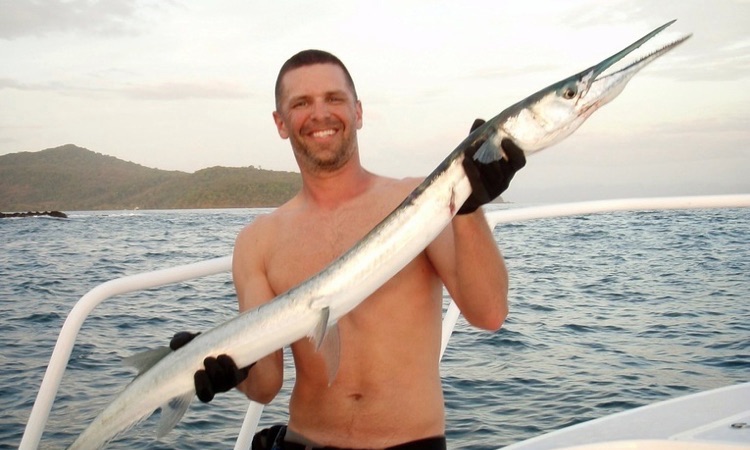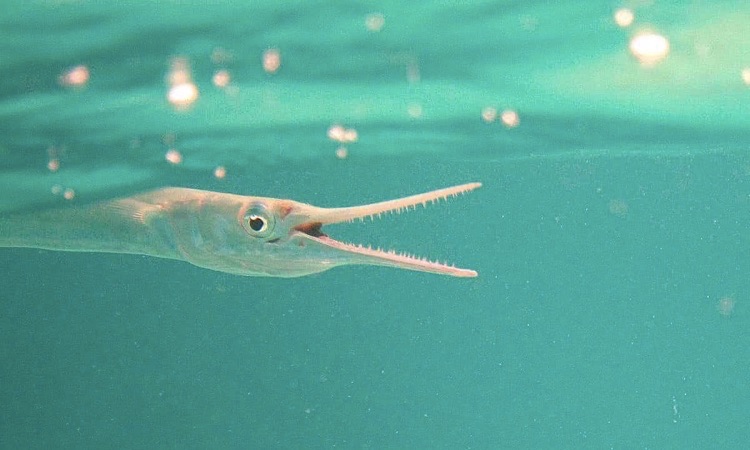The needlefish is distinguished by a thin streamlined body and a needle-like beak. Although it isn’t the largest fish in the ocean nor the toughest, the needlefish has taken a few human lives throughout history.
Many divers and night fishermen are unknowingly threatening this creature and get impaled by its needle. Read on to learn more about this fascinating fish.

What is a Needlefish?
The needlefish is also known as the Long Tom because of its elongated form. Its long and thin body shape has earned it the name. The elongated mouth of the fish resembles a needle, hence the name. A needlefish has an incredibly streamlined physique that allows it to swim at high speeds.
They can live up to 8 years and some species may grow more than one meter long. It’s mostly dependent on its vision when hunting.
The needle-like beak is studded with sharp teeth. The needle fish family includes up to 35 distinct species of fish that may be found in a variety of freshwater and marine bodies across the world. For easier classification, the species are divided into 10 different genera.
Quick Facts
- Needle fish don’t have a stomach. Their digestive system, on the other hand, produces the enzyme trypsin, which aids with the breakdown of food.
- Their bones and flesh are blue or green in color.
- The needle fish can reach speeds of 60 kilometers per hour and jump out of the water. Instead of swimming underneath, they are purported to leap over little boats.
- They’ve been linked to two fatalities thus far, but they are typically non-harmful to people.

Threat to Humans
Despite their modest size, needlefish are dangerous to humans in certain circumstances due to their lengthy, thin form with sharp teeth and unique leaping behavior.
Human attacks by needle fish are very rare, but when it leaps out of the water with its needle pointed at a possible danger, it has the ability to burst organs like eyes, heart, intestines, and lungs.
There have been several documented cases of people dying after being stabbed by the needlefish. A fisherman in the Philippines was killed by a leaping needlefish. Jesus Guerrero was fishing off Sitio Gapuh early Tuesday morning when a needlefish, known locally as “balu,” leaped out of the water and impaled itself on his throat.
Despite his efforts, he was unable to extract the 30cm/12″ fish from its stomach. However, minutes later, despite his son and brother’s attempts to assist him, he died as a result of attempting to remove it.
A 90cm/3′ needlefish stabbed a 16-year-old boy through the heart while diving in northern Vietnam in 2007. It’s thought the fish became startled by the boy and, as it tried to flee, stabbed him inadvertently.
In 2009, a man was wounded in the face by a needlefish after it leaped from the Mediterranean Sea and pierced his nasal cavity, entering his nasal cavity. A needlefish jumped from the water in Guadeloupe in 2004 and impaled a guy in his eye socket.
Habitat and Population
Needlefish are a large family of fish that can be found in a variety of freshwater and marine habitats throughout the world. They live near the surface and hunt for small fish, octopuses, and crustaceans while smaller individuals feed on plankton.
Although males tend to guard a small domain while feeding, tiny schools of needle fish may be observed. They are fast hunters that use an upward swipe of the head to grab their prey and bite with their sharp teeth.
Unfortunately, they are unable to live where there are no predators since they have thin, fragile bodies and weak bones, making them highly susceptible to predation.
Needlefish are a frequent source of food for larger fish and animals like sharks and dolphins. They are hunted by birds such as eagles, hawks, and ospreys. Human fishing activities have a minor influence on their populations across the globe.
The market potential for this fish is low, since their green bones and meat give them a bad appearance. The needlefish population is increasing, with no species being at risk.

Predators and Prey
Because of their small size and lack of a protective shell, they are very vulnerable to larger fish. Tuna, dolphins, and humans that capture and consume them are also eaten by them.
Their habit of swimming near the water’s surface with tiny bodies and thin bones makes them easy prey for eagles, hawks, and ospreys.
However, since they are ubiquitous across the world, they are not considered threatened. Needlefish eat a wide range of prey, including tiny fish and crustaceans such as shrimp, killifishes, octopuses, and silversides.
Freshwater species eat tadpoles, frogs, and insects. Until they are big enough to consume other prey, juvenile needlefish consume plankton.
The majority of needle fish species have a thin body with faint dorsal fins and anal fins. These fish may use their speed and accuracy to attack swiftly and precisely.
They may also use their leaping movements to hunt, as they utilize the momentum after returning to the water to capture tiny fish.
They frequently stalk prey and grab them with a sideways maw sweep. Although they are not aggressive hunters, but they will sometimes eat copious amounts on one day and barely eat the next.
Reproduction and Lifecycle
The majority of the mating occurs in April and May. When males locate females, they compete with one another for access to them.
The male is larger and rides on top of the female during mating. The needle fish is oviparous, laying its eggs in shallow waters. For the most part they migrate to shallow seas for spawning.
They attach a thousand eggs to each other or a host plant, which then hatch in 10-15 days and generate many tiny needlefish.
The upper jaw of juvenile needlefish is considerably smaller than the lower jaw. Because this upper jaw is not completely developed, it is unable to hunt during what’s known as the “half-beak” stage.
During this period they feed on plankton and other tiny marine animals for the first six months. When the upper jaw is fully developed, the fish switches to hunting small fish, squid, and crustaceans.
There have been no reports of hybrids or interbreeding among the various species of needlefish in the world, in spite of there being up to 35 different types.
Fishing and Cooking
Needlefish are gamefish when captured using trammel nets, casting with a lure, and trolling at the water’s surface.
They are a favorite dish in certain regions of the world, particularly Central and South America and much of the Caribbean. Angelhinha Frito is a typical needlefish dish served along Brazil’s beaches.

Population
The exact number of needlefish in the world is unknown, although they are common across many regions. Their IUCN Redlist conservation status is “least concern.”
Evolution
Because of the paucity of fossil records and study, little is known about the needlefish’s evolutionary history. However, genes taken from garfish indicate that land animals began developing hands and paws. This indicated that they must have evolved from a long-extinct lineage and be a close relative to the ancestors of terrestrial creatures.


